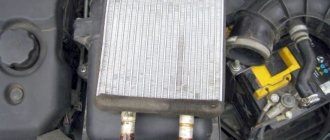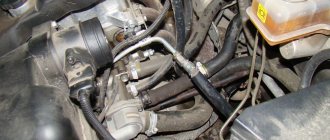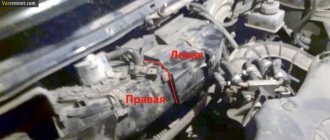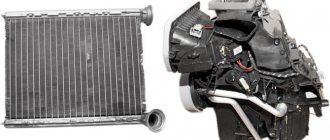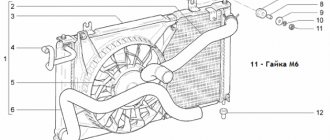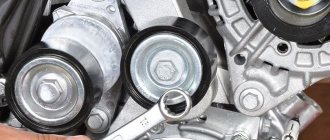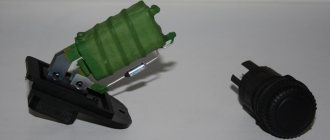The stove heating system on the Lada Granta car functions quite well, the owners have no complaints. The stove radiator is reliable and durable. However, there comes a time when the process of metal corrosion begins and the seams peel off. A faulty heating system can cause a lot of trouble, especially in sub-zero temperatures.
Frosting of windows and cold inside the cabin are the first symptoms of unstable operation of the heating system. Prevention is necessary.
Let's look at the step-by-step process of replacing the heater radiator on a Lada Granta car.
Lada Granta car engine
The first Lada Granta sedan cars had 2 configurations - standard and norm. Under the hood of the grant, an 8-valve engine with a volume of 1.6 liters is installed. There are two modifications of it - 80 hp. and about 90 hp. This power unit accelerates the Grant to 100 km/h in 12 seconds, which is not bad for a budget car. Combined cycle consumption is no more than 7.3 liters per 100 km. In the suburban cycle, consumption drops to 5.5-6 liters. at a cruising speed of 100-110 km/h. With all this, the engine complies with the Euro-4 eco-standard, and work on the development of Euro-5 is gradually beginning. With the appearance of the “Lux” configuration on the Grant, a version of the engine from Renault coupled with an automatic transmission will be available. Such an engine will have a power of 98 hp.
If the fan does not turn on
If the RTD has risen to 100 degrees and the indicator needle has entered the red part of the scale, this indicates overheating. Perhaps this phenomenon occurred due to the fact that the fan did not work. If you find that when it overheats, the fan does not start working and the temperature does not drop, you need to check the serviceability of the fan itself. It is necessary to determine whether the switch-on sensor is triggered when the normal RTD is exceeded? First, start the engine and disconnect the wires from the temperature sensor that is installed on the engine. When the wires are disconnected, forced cooling should work. If this does not happen, most likely the fault lies in the electric motor of the device. How to check the operation of the fan, watch the video.
This malfunction is quite easy to fix: you just need to replace the sensor. After replacing it, check if the fan turns on. To do this, start the engine. When the RTD reaches normal levels, do not turn off the engine until the temperature exceeds the norm. As soon as this happens, the fan should be activated. If the fan operates at a temperature above 97 degrees, but less than 100 degrees, then the system is functioning properly.
Evgeny161 › Blog › Installing an air conditioner in a grant
Have a good day everyone!
I would like to share with you a post about installing the original Halla-visteon factory air conditioner (NOT AUGUST OR FROST) in GRANTA.
As it usually happens, either here on the drive, or on VKontakte in my group avtoklimat161, or in the advertisements on Avito, the owner of this grant found me...
The car is like a car and there is no air conditioner... Having told the owner about the options for installing new or used equipment, about the cost (new turnkey 50, used - 35), we agreed that we will install used equipment, especially since this year I have thoroughly stocked up on such equipment, because I think that new ones are sooooo expensive, but used ones, during pre-sale preparation, are no different in either quality or operational efficiency!
In my opinion, the Granta is best suited to be equipped with air conditioning. The installation process is not particularly complicated, a standard “locksmith” - unscrewed - removed - took another - installed - screwed.
But there are things with which there are problems with grants!
1. On cars without air conditioner there is NO belt tensioner mechanism! That is, you need to buy a Kalinovsky generator bracket with an adjusting screw and a roller.
2. The most important thing is that on grants, depending on the ECU model and firmware, you must use either a THREE-CONTACT coolant pressure sensor or a FOUR-PIN! And they are not interchangeable! Apparently, this is why FROST kits do not have a connection to the computer, so as not to worry about what firmware is there and what unit is there. And this is categorically NOT CORRECT! ! THE ECU SHOULD KNOW THAT THE AIR CONDITIONING IS ON. MOREover, IT IS THE ECU THAT TURNES ON THE MAIN FAN AND COMPRESSOR AND CORRECTS THE IDLE SPEED, AND ALSO TURN OFF THE COMPRESSOR WHEN SHARPLY PRESSING THE GAS PEDAL, THUS MAKING IT EASIER FOR THE ENGINE TO GET RPM SHARPLY - IT HELPS VERY WHEN OVERTAKING ESPECIALLY ON TRAIN.
So, if we have a kit with a three-pin sensor, but the computer “does not understand” it, then we need to solder a fitting into the high-pressure pipe to install another, four-pin pressure sensor. The connection diagram in the ECU connector also changes.
Otherwise, everything falls into place without problems.
I make the wiring harness myself so as not to change the factory engine compartment and interior harnesses (the process is the same)
We vacuum, then pump 500 grams of freon and meet the long-awaited degrees)))
For questions regarding the purchase and installation of air conditioners in 2110/Priora/Kalina/Grant/Chevy Niva, write in a personal message here, go to the VKontakte group avtoklimat161, or call 89185412751 or 89896232525. This number also has WhatsApp and Viber.
source
Recommendations for the selection of parts and components
The range is represented by domestic manufacturers, originals and high-quality analogues. The final choice is up to the owner of the technical device.
Service center technicians strongly recommend purchasing original parts. The service life and manufacturing quality of factory components are an order of magnitude higher than their analogues.
Before purchasing, carefully check the spare part catalog numbers with the actual data in the instruction manual. If necessary, get free consultations from service station specialists.
New Lada: New Lada Granta 2022
Lately it has become popular to order parts for subsequent installation directly in workshops. There are many advantages of this choice: prompt delivery, professional installation, quality guarantee.
Reviews
| № | Positive |
| 1. | Vasily: for two years of operation there were no breakdowns of the heating system. Several times I noticed an antifreeze leak at the joints of the pipes. After replacing the clamp with a new one, there were no cases of depressurization. |
| 2. | Vladlen: Granta is assembled with high quality, the fit of parts is good, there are no comments. Provided regular maintenance, it will last a long time. |
| 3. | Gennady: for a year and a half of active use of the machine, I did not make any capital investments, with the exception of the purchase of consumables. I treat equipment with care, I buy only original parts. |
| 4. | Ivan: I recently underwent the fifth maintenance, the master assured me that the equipment was in good working order, there were no comments. |
| 5. | Dmitry: at 50,000 km, I replaced the return pipe once due to the formation of a crack. The system is operating normally, there are no complaints. |
| 6. | Ignat: my machine works like a watch, no complaints. I carry out technical inspections in a timely manner, fill with high-quality oils and high-octane fuel, and strictly follow the manufacturer’s recommendations. |
| 7. | Victor: It will soon be two years since I bought a Lada, I’m happy with the choice. My friends advised me to buy a Renault Logan, but I chose a domestic one. |
| Negative | |
| 1. | Ivan: I’m dissatisfied with the purchase of the Lada Grant; in the first winter, the antifreeze supply pipe to the radiator cracked. Fortunately, I noticed it in time and replaced it with a new one, otherwise the consequences could have been different. |
| 2. | Sergey: during the year and a half of operation of the car, the car underwent unscheduled repairs twice. I think this is too much for domestic transport. |
| 3. | Gennady: Now I regret buying Granta; Renault Logan is better. The car is falling apart every day. |
Conclusion There are difficulties when dismantling the stove heater. Many owners are familiar with this. At the same time, the “craftsmen” came up with a way to replace the heat exchanger without actually removing the dashboard, which significantly reduces time, money, and effort.
The final choice is up to the owner of the technical equipment. You should still listen to the recommendations of experts.
Eliminating air jams
The design of the cooling system in the VAZ-1118 has one unpleasant drawback - the tendency for the circuit to become airy. This can lead to overheating and engine damage. Here we recommend resorting to minor system upgrades. You need to act when the liquid is drained.
- First we replace the thermostat. Instead of a standard product with five holes, we install a component with six such holes.
- We add a refrigerant filter to the circuit.
- We install a shut-off valve on the pipe leading to the stove.
These actions are not capable of radically transforming the system. Experienced owners of LADA Kalina have moved further in this matter. They add steam exhaust pipes, install a forced fan activation button, etc. To install the designated outlet, the diagram looks like this: we cut a tee into the pipe leading to the expansion tank. It is connected through a separate hose to the pipe of the throttle body heating unit. We place the second tee in the return from the radiator of the heating system and connect it with an expansion tank. Now you know how to remove, as well as how to change the radiator, and fix other problems yourself.
Refinement of the cooling system
Domestic cars are far from perfect, that's a fact. Lada Priora was no exception in this regard, having inherited many shortcomings from the legendary “ten”. One of them is an unfinished cooling system.
There are several ways to quickly and without financial costs modify the SOD on Priora.
- Installing a 6-hole thermostat (stable maintenance of coolant temperature).
- The use of Kalina SOD on Priora will reduce the pressure in the system and provide quick warm-up at subzero temperatures.
- Installing a larger or additional water pump to improve coolant circulation efficiency.
- Use of multi-speed and silent forced cooling fan.
- Changing the firmware of the control unit so that the fan operates at a lower temperature.
Refining the cooling system of the Lada Priora is a feasible task even for novice car enthusiasts. The SOD has a simple design with a minimal set of components. Thanks to this, the system is relatively reliable.
Source
Replacing the Lada Granta heater radiator
If it's cold in the cabin when the heater is on, it means it's time to repair or replace the heater. Among the most typical reasons why you have to change the heater radiator on a Grant:
- clogging of channels due to the formation of scale or dirt;
- the occurrence of cracks or holes in the heating system.
In some cases, it is possible to get by with repair and restoration measures. For example, before changing the radiator, you can try flushing the system with a special liquid. There are means to get rid of scale inside the heating system, both by draining the antifreeze and the coolant inside. Such products, as a rule, do not harm sealants, gaskets, hoses, etc.
In some cases, it is possible to repair the heater radiator of a Lada Granta car without having to replace it
What is needed to replace a stove radiator?
When starting to replace the radiator, you need to prepare:
- set of clamps;
- sealant;
- antifreeze;
- Phillips screwdriver;
- key to 10;
- insulation (foam rubber);
- file.
Of course, you should purchase a new radiator in advance, and a “original” one, since the heat exchanger of other models will not work.
Sequence of steps when replacing a radiator
Work on dismantling the old radiator can begin from the engine compartment. Here, to create access to the elements of the heating system, it is necessary to remove the battery, the air duct pipe between the throttle assembly and the air filter, as well as the air filter itself.
Then you need to empty the system of coolant by draining it into a previously prepared container. Obviously, if a car owner intends to fill in new antifreeze at the end of the work, the old one does not need to be saved.
Before replacing the heater radiator of a Lada Granta car, you must remove the battery and air filter
The next stage of work is carried out from the interior. To gain access to the heater radiator, you will first have to remove the gas pedal: without this, it is not possible to remove the heat exchanger. Dismantling the pedal, as a rule, does not cause any difficulties: using a 10mm wrench, unscrew the three fastening nuts and disconnect the brake light limit switch and the connector for the electronic gas pedal. In addition, you need to press the brake pedal and lock it in this position.
Next, the plastic cover covering the radiator is removed, after which access to the heat exchanger opens. After this comes the most crucial moment - sawing off the radiator pipes: you should saw off after bending so that the cut part can be removed through the hole into the engine compartment. After both pipes are removed, you can remove the radiator from the niche into the car interior.
To dismantle the old radiator, you need to saw off its pipes
The pipes on the new radiator should also be sawed off so that later hoses can be put on them and secured with clamps. The cut edges of the pipes should be processed with a file, the holes in the engine compartment are filled with foam rubber to provide additional fixation to the structure and to preserve heat in the cabin.
Akhmed Fazilov
https://grantaremont.ru/content/pechka
It is more convenient to carry out the work of replacing the heater radiator together: one supplies the pipes from under the hood, the second receives them in the cabin. Sealant should be applied to the pipes of the new radiator and, after connecting to the flexible hose, securely secured with clamps. After this, you need to assemble all the removed parts: gas pedal, battery, air filter, then fill the system with antifreeze. At the end, you should check how the new radiator works: you need to start the engine and let it run for a few minutes, then visually make sure that the antifreeze level has not dropped, there are no leaks, and the heat exchanger has warmed up.
There are no fundamental differences in the procedure for replacing the heater radiator on a Lada Granta with and without air conditioning (unlike replacing the cooling radiator).
Video: personal experience of the Lada Granta owner in replacing the heater radiator
Stable and uninterrupted operation of all vehicle systems can be achieved by constant monitoring of their condition. The serviceability of the Lada Granta heater radiator becomes especially important in winter, therefore, in the process of preparing the car for the cold season, it would be useful to check its readiness for the season, especially if the vehicle is expected to operate at a high intensity in winter conditions. Practice shows that with proper operation, a stove radiator can serve properly for many years, but if it still fails, it is quite possible to replace the heat exchanger yourself.
FakeHeader
Comments 23
so what did you decide? Will the grant expire in 15 years or not? otherwise radik potik(((
Damn, it’s a pity there are no sizes, maybe the radiator is a new type, if it’s larger, it will fit on Kalina 1 without any problems
It won’t fit, you’ll need to make a transition frame!
Well, the old model won’t work, but if it’s bigger than the new one, why not?
It is not much larger than the old model. Viburnum1 is still healthier.
Well, the old model won’t work, but if it’s bigger than the new one, why not?
If necessary, I will contact the sellers and compare))
Hello, what kind of radiator did you install in the end? I also encountered a clogged stove and want to install a new one
Hello! They didn’t experiment and installed the old model. I needed a car very urgently. With the new sample, who knows whether it will stand up or not... You can see from the photo that it is thicker
Hello, what kind of radiator did you install in the end? I also encountered a clogged stove and want to install a new one
Thank you, I have already ordered just such a radiator, I’m waiting for it to arrive and will try to install it, because the website claims that it will not fit for 2014
Replacement procedure
- After the engine has cooled, unscrew the coolant expansion tank cap. The lid must be opened to equalize the pressure in the system.
Loosen the coolant drain plug on the engine block. The plug is located under the ignition unit.
Place a container to collect the liquid and unscrew the cap completely. Head plug for thirteen.
Press the lock and remove the power connector from the electronic gas pedal.
Unscrew the three nuts securing the gas pedal and remove it. Ten head nuts. Press the latch and disconnect the power connector for the brake light button.
Disconnect the brake pedal from the brake booster. To do this, remove the locking ring using pliers and remove the pin that fits through the hole in the pedal and the VUT bracket.
Unscrew the two screws securing the plastic cover that makes access to the radiator difficult. Phillips head screws.
Unscrew the three nuts securing the gas pedal bracket and remove it. Ten head nuts.
In the engine compartment, disconnect the power connector to the mass air flow sensor. Loosen the clamp on the pipe going to the intake manifold. Next, disconnect the plastic pipe for the air intake and remove the air filter housing assembly. Clamp for a slotted screwdriver or 8mm head.
Loosen the clamp and remove the pipe coming to the thermostat. Also remove the pipe connected to the pump. Head clamps for thirteen.
Each pipe contains a little more coolant. It is best to place the end in a collection container after removing the pipe.
Remove the insulation from the engine shield so that it can be reused.
Cut or saw through the two aluminum tubes that go to the radiator. Cut off the tube that is closest as short as possible.
Remove the radiator from its seat. When dismantling, it is best to place the brake pedal between the radiator tubes.
Glue the seal onto the new radiator, just like it was on the old one. Most often, the seal comes with the radiator.
Cut the pipes on the new radiator as shown in the photo below.
Clean the seat and install the radiator.
Place two clamps on the radiator tubes and lubricate the pipes with a sealing compound. Insert the pipes from the side of the engine compartment. Direct the heads of the clamps towards the radiator so that there are no problems with the plastic cover during installation.
Glue the insulation near the pipes. Mount the gas pedal bracket and secure with three nuts. Install the plastic cover for the radiator pipes and secure with two screws. Connect the brake pedal to the vacuum booster. Connect the brake light button power connector. Install the gas pedal and secure with three screws. Also don't forget to connect the power connector. Cut the pipes to size. Trim the pipes so that they are not strained and there are no kinks. Fill the radiator with coolant.
Lubricate the pipes with a sealing compound and secure them to the thermostat and pump.
Install the air filter housing and connect the mass air flow sensor. Pass coolant through a sieve and pour into the system. Start the engine and check connections for leaks.
You can see the procedure for replacing the Lada Granta heater radiator in this video:
This is interesting: How to change the coolant temperature sensor of a VAZ-2114 (video)
Engine operating temperature on the VAZ-2110 - is there a difference?
Despite the fact that 8 and 16-valve VAZ engines have a slight difference in the design of the cooling system, the operating temperature for both engines is the same.
Engine operating temperature on the instrument panel.
The factory provides a normal engine operating temperature ranging from 87 to 103 degrees. Maintaining the temperature within these limits can be greatly influenced by certain issues related to the performance and quality of the cooling system elements. Let's look at each of them briefly.
Cooling radiator
Boiling of the coolant can be caused by a clogged cooling radiator, and it can become clogged both inside and outside.
Clogged honeycombs of the engine cooling radiator.
Cleaning the radiator regularly will ensure normal engine operation and will help prevent antifreeze from boiling.
When checking the condition of the radiator, we pay special attention to the presence of leaks and the integrity of the honeycombs, the absence of cracks in the tanks and the condition of the pipes
The water pump is responsible for the complete circulation of coolant through the cooling and heating system.
Antifreeze leaking from under the pump.
Maintaining the normal operating temperature of the antifreeze also depends on the efficiency of the pump. The main pump malfunctions include bearing failure, leakage and destruction of the pump impeller.
This can occur as a result of both physical damage to the impeller and destruction as a result of cavitation processes. Cavitation is most often caused by the use of low-quality antifreeze or untimely replacement.
Most of the complaints are made specifically to the thermostat, the bypass valve, which directs the coolant in a full or small circle, depending on the degree of heating.
Thermostat location under the hood.
For example, the engine may not warm up to the legal 87–90 degrees due to a stuck valve. However, most often thermostat malfunctions occur due to the quality of the thermoelement. Despite the fact that each thermostat is marked on the body, which indicates the valve response temperature, the indicated temperature does not always correspond to reality.
So, at the specified operating temperature of 85 degrees, the thermostat can pass liquid in a large circle already when warming up to 75–80 degrees. As a result, the temperature will not correspond to the norm, the engine will not be able to warm up to the optimal value. The only solution is to test the thermostat before installation. To do this, the thermostat body is placed in a vessel with water and heated to the specified temperature, periodically checking the condition of the valve. A discrepancy between the thermostat response temperature, even by 3–5 degrees, will not allow you to obtain the optimal operating temperature while driving.
Sensors, ECU firmware and fan
The accuracy of the coolant temperature sensor also greatly affects operating temperature.
The temperature sensor is located near the thermostat housing.
The sensor sends an electrical impulse to the electronic control unit, which in turn gives a command to start the cooling fan. The normal temperature at which the fan should start is 105 degrees. If the sensor readings are incorrect, the fan will start earlier (in this case the antifreeze will not warm up to normal) or later
Then the engine may overheat and the antifreeze may boil, especially antifreeze of poor quality.
Replacing the generator on the Lada Grant with an 8-valve
Preparatory stage
Tools, materials:
- metal mounting blade;
- set of auto tools;
- rags;
- rust remover WD-40.
Sequencing:
- We place the car within the perimeter of the repair area, provide priority safety measures, and fix the wheel chocks.
- We remove the terminals from the battery to avoid a short circuit in the circuit (key to “10”).
- From under the bottom of the car, unscrew the 8 bolts securing the oil pan protection and remove it.
- Disconnect the block with wires from the converter (generator).
Block with wires
- Remove the rubber cap and terminals from the back of the converter.
- The key is set to “13”, unscrew the top bolt - the generator position lock.
- We move the converter forward until it stops against the radiator.
Moving the converter
- From under the bottom of the car, unscrew the second bolt - the clamp, and remove it.
- Having loosened the fixation of the converter, we remove the belt from the pulleys.
We remove the generator, carry out preventive measures (replace with a new one), and assemble the structure in the reverse order.
Control unit for heating and ventilation system Lada Granta
The heating, air conditioning and ventilation system of the Lada Granta is a single complex that provides the most comfortable conditions inside the car, regardless of weather conditions and driving conditions.
The system control unit panel is installed on the instrument panel console.
Heating and ventilation system control unit:
1 – air temperature regulator;
2 – fan operating mode switch;
3 – air flow distribution regulator;
4 – air recirculation control lever;
5 – rear window heating switch.
Outside air can enter the car interior through the central and side deflectors of the heating and ventilation system, into the area where the feet and head are located and onto the windshield.
The intensity of air supply into the cabin is regulated by turning the handle of the fan operating mode switch. This turns on one of four fan speeds. Turn the switch handle clockwise to increase the fan speed.
The position of the flow distribution control handle sets the following directions of air flow in the cabin
1. The air flow enters the lower part of the passenger compartment, into the driver’s and passengers’ foot areas, as well as through the air nozzles to the windshield and front door windows of the car;
2. The air flow through the blower nozzles reaches the windshield and windows of the front doors of the car;
3. The air flow through the side and central deflectors enters the upper part of the car interior to blow air over the driver and passengers.
4. The air flow enters the lower part of the cabin, to the driver’s and passenger’s foot areas.
Air temperature regulator
By turning the air temperature control knob, change the temperature of the air entering the cabin.
To increase the air temperature, turn the control knob to the left, to the red sector of the scale, and to decrease the air temperature, turn to the right, to the blue sector. With its help, you can determine where the stove gets air from - from the interior or outside. You need to take it from the interior when there is an unpleasant smell outside, or you need to warm up the car faster.
Recirculation system control lever
To turn on the recirculation mode, move the lever to the extreme right position. When the recirculation mode is turned on, outside air does not enter the cabin, and the air blower fan circulates air inside the cabin. This mode is used to quickly warm up the interior in the cold season, as well as when the surrounding air is dusty and gassy.
To allow outside air to enter the cabin, move the lever to the extreme left position.
The directions and intensity of air flows through the side and central deflectors of the ventilation and heating system are regulated by correspondingly rotating the guide vanes until they are completely open and rotating the deflector body.
Note:
It is not recommended to turn on the recirculation mode for a long time while the car is moving, as this usually leads to fogging of the windows.
Heated rear window switch
The heated rear window is turned on and off by pressing the button when the ignition is on. It is turned on by a button located below the handle.
Signs of a broken stove
A stove breakdown always entails discomfort, especially in the cold season. The most typical signs of heater failure are frozen glass and a drop in temperature inside the cabin. Malfunctions result from:
- The presence of obstruction inside the channels due to scale;
- Use of low-quality antifreeze (both constant and irregular);
- The presence of foreign objects in the heating system or its contamination.
The main symptoms of a radiator failure include the following:
- Even when the engine is warm, cold air enters the car interior from the deflectors;
- There is a clear lack of interior heating; warm air begins to flow only after a sufficiently long wait from the moment the engine is started.
To prevent possible breakdowns, experienced car owners recommend periodic inspections of the entire heating system, as well as the cooling system. Having discovered any suspicious stains or leaks, you must immediately begin carrying out repair and preventative measures. If you find damaged pipes or hoses, replace them immediately. Such inspections will insure you against possible negative consequences caused by a sudden breakdown of the heater.
Recommendations for the selection of parts and components
The range is represented by domestic manufacturers, originals and high-quality analogues. The final choice is up to the owner of the technical device.
Service center technicians strongly recommend purchasing original parts. The service life and manufacturing quality of factory components are an order of magnitude higher than their analogues.
Before purchasing, carefully check the spare part catalog numbers with the actual data in the instruction manual. If necessary, get free consultations from service station specialists.
Lately it has become popular to order parts for subsequent installation directly in workshops. There are many advantages of this choice: prompt delivery, professional installation, quality guarantee.
Work resource
The manufacturer states that the 126 by 16 valve engine can operate stably for 200 thousand kilometers. After this limit, the power plant requires major overhaul. But do not forget that AvtoVAZ is a real lottery; for some Priora owners, the engine caught a wedge at 2 thousand. But if you take care of your Lada car, regularly perform maintenance and replace damaged components, then you can safely count on a service life of 150-200 thousand km.
The resource of the power plant is influenced by many factors, here are some of them:
- Overheat. Running the engine on a Priora at elevated temperatures significantly reduces its service life. The operating temperature, which we will talk about in the next section, must be maintained at the same level.
- Fuel. The instruction manual indicates what kind of gasoline should be poured into engine number 126 with 16 valves. It is also recommended to visit only trusted gas stations that will not fill you with diluted fuel.
- Engine oil. Everything is simple here - change the lubricant in a timely manner and buy high-quality oils, then the service life will be 150-200 thousand km. For the 16 valve unit 126, semi-synthetics (Lada recommendation) and synthetics are suitable. The oil needs to be changed once a year or every 15 thousand kilometers; as you can see, the fluid does not have a long service life.
Replacing the stove radiator on a Lada Granta with your own hands + video
Lada Granta has become a really popular car. And, in many ways, this happened thanks to the affordable price and good components. For example, the stove installed on the Lada Granta is quite good, as it warms up the interior to the required level very quickly. AvtoVAZ engineers did a very good job on this issue, since for our harsh winters the issue of high-quality heating of the interior is very relevant.
| TOP 15 most useful products for Lada Granta - OUR EXPERIENCE! |
- 1 Dismantling the Lada Granta heater radiator 1.1 Installing a new Lada Granta radiator
- 1.2 Selecting a new heater radiator (tested articles)
- Ratchet driver;
- Extension;
- Crosshead screwdriver;
- Cooling system sealant;
- Head for eight, ten, thirteen;
- Slotted screwdriver;
- Pliers;
- Powerful wire cutters or small grinder;
- Pipes for the cooling system with an internal diameter of 16 and 18 mm (length 1 meter);
- Six worm clamps with a grip range of 15-25 mm.
- After the engine has cooled, unscrew the coolant expansion tank cap. The lid must be opened to equalize the pressure in the system.
Loosen the coolant drain plug on the engine block. The plug is located under the ignition unit.
Place a container to collect the liquid and unscrew the cap completely. Head plug for thirteen.
Press the lock and remove the power connector from the electronic gas pedal.
Unscrew the three nuts securing the gas pedal and remove it. Ten head nuts. Press the latch and disconnect the power connector for the brake light button.
Disconnect the brake pedal from the brake booster. To do this, remove the locking ring using pliers and remove the pin that fits through the hole in the pedal and the VUT bracket.
Unscrew the two screws securing the plastic cover that makes access to the radiator difficult. Phillips head screws.
Unscrew the three nuts securing the gas pedal bracket and remove it. Ten head nuts.
In the engine compartment, disconnect the power connector to the mass air flow sensor. Loosen the clamp on the pipe going to the intake manifold. Next, disconnect the plastic pipe for the air intake and remove the air filter housing assembly. Clamp for a slotted screwdriver or 8mm head.
Loosen the clamp and remove the pipe coming to the thermostat. Also remove the pipe connected to the pump. Head clamps for thirteen.
Remove the insulation from the engine shield so that it can be reused.
Cut or saw through the two aluminum tubes that go to the radiator. Cut off the tube that is closest as short as possible.
Remove the radiator from its seat. When dismantling, it is best to place the brake pedal between the radiator tubes.
Glue the seal onto the new radiator, just like it was on the old one. Most often, the seal comes with the radiator.
Cut the pipes on the new radiator as shown in the photo below.
Clean the seat and install the radiator.
Place two clamps on the radiator tubes and lubricate the pipes with a sealing compound. Insert the pipes from the side of the engine compartment. Direct the heads of the clamps towards the radiator so that there are no problems with the plastic cover during installation.
Glue the insulation near the pipes. Mount the gas pedal bracket and secure with three nuts. Install the plastic cover for the radiator pipes and secure with two screws. Connect the brake pedal to the vacuum booster. Connect the brake light button power connector. Install the gas pedal and secure with three screws. Also don't forget to connect the power connector. Cut the pipes to size. Trim the pipes so that they are not strained and there are no kinks. Fill the radiator with coolant.
Lubricate the pipes with a sealing compound and secure them to the thermostat and pump.
Install the air filter housing and connect the mass air flow sensor. Pass coolant through a sieve and pour into the system. Start the engine and check connections for leaks.
You can see the procedure for replacing the Lada Granta heater radiator in this video:
Adviсe
Antifreeze leaked into the cabin
To prevent problems with the heater core, you need to carefully monitor it. For example, from the first days of buying a car, periodically look under the car to see if there are dark spots there. And in the engine compartment it would be a good idea to observe the condition of the cooling system hoses. If you notice traces of antifreeze in any of these places, you need to immediately seek help, or carry out repairs yourself.
If possible, the hoses for connecting the heater radiator should be replaced with new ones, having coated the connection points with sealant. But some do not agree with this opinion. After all, sealant from the hose can get inside the cooling system and cause damage to the pump. As a result, the timing belt will break and the valves will meet the pistons.
Replacing the Lada Granta generator - KZATE with Bosch. Comparative characteristics and disadvantages
| Characteristics | KZATE 115A 2170-10 | Bosch 2170-13 |
| Maximum current (output) at 14.5 V / 6000 rpm | 115 | 110 |
| Voltage setting limits at a speed of 2500 rpm and a current of 5.0 A | 13.6 – 15.2 | 13.6 – 15.2 |
| Gear ratio according to the principle: motor - converter | 1 : 2.4 | 1 : 2.4 |
Due to its smaller height, Bosch 110A is 10 mm lower than its analogue. Despite the minor advantages, BOSCH has one “fat” drawback - there is no possibility of quick (cold) replacement of the diode bridge in the event of its failure.
The electrical contacts are soldered into the bridge; quick replacement of the rectifier on the road will not work. At KZATE it is quite possible and acceptable to replace the rectifier on the road.
Addresses of companies providing generator replacement services (Moscow, St. Petersburg, Kyiv regions)
| № | Name | Address |
| 1. | "Autopoints" | Moscow, Varshavskoe highway, 33 https://avtotochki.ru/ |
| 2. | "ZenitAuto" | Moscow, metro station Perovo, Kuskovskaya st., 20A (next to the Enthusiasts Highway) https://www.zenitauto.ru/ |
| 3. | "RemZone" | St. Petersburg, Vasilievsky Island, st. Uralskaya, 17A https://www.spb-remzona.ru/ |
| 4. | "Autopoints" | St. Petersburg, Lesnoy Avenue, 78 https://spb.avtotochki.ru |
| 5. | "Dzigora Complex" | m. Darnitsa, st. City Shalet 1A https://dzigoracomplex.kiev.ua/ |
| 6. | "VseSTO" | Kyiv, st. Kikvidze 43 https://vse-sto.com.ua/ |
Difference between belts of 16 and 8 valve engines
For Lada Granta models, an alternator belt with the following markings is used:
- 1118-1041020-07: search index 6RK 823, length 823 mm, thickness 3.0 mm;
- 6PK1123 with air conditioning;
- 6PK1113 without air conditioning, with power steering;
- 6PK745 without air conditioning, without power steering.
Review of Manufacturer Prices
Heater parameters: weight 0.5 kg, length 155 x width 167 x height 20 mm.
| Name/article | Price, rub.) |
| Heater radiator 2190-8101060 | From 2400 |
| 21900-8101060-00 | —/— |
| 21900-8101060-10 | —/— |
| 27140-5PA0A | —/— |
| LUZAR aluminum LRh 0190b | From 2100 – 2200 |
| LUZAR LRaC 0190 | —/— |
| LUZAR 482768 | —/— |
| LUZAR 353287 | —/— |
| AvtoVAZ OJSC 429612 | From 2300 |
| with air conditioning for automatic transmission LUZAR 367792 | From 2400 |
| AvtoVAZ OJSC 348402 | —/— |
| LUZAR 466443 | —/— |
Related link:
Tips from experts on replacing the thermoelement in the Lada Granta thermostat
*prices are current as of November 21, 2018.
Removing the radiator
Removing the Lada Granta radiator (VAZ 11183, 21116)
We remove the radiator to check it for leaks (if a leak is suspected) or replace it if damaged.
Drain the liquid from the cooling system (see “Replacing the coolant”).
Remove the radiator fan (see “Removing the radiator fan”).
It is more convenient to dismantle the radiator complete with hoses.
Therefore, we disconnect the radiator inlet and outlet hoses from the pipes of the thermostat housing and the pump inlet pipe, respectively, and disconnect the radiator steam exhaust hose from the expansion tank fitting.
Using a 10mm socket, unscrew the two nuts securing the radiator to the upper cross member of the radiator frame. We tilt the radiator towards the engine so that it comes out from under the upper cross member of the radiator frame, lift the radiator...
...and remove it complete with hoses from the engine compartment.
Radiator complete with hoses. To remove the radiator supply hose...
...we use pliers to compress the ends of the clamp and, sliding the clamp along the hose...
...remove the hose from the pipe of the right radiator tank. We disconnect in the same way...
...from the pipe of the left radiator tank there is a radiator outlet hose...
...and from the fitting of the left tank - a steam removal hose (when removing the hose from the fitting, be careful not to break the fitting). When replacing the radiator...
...using a 12mm head we unscrew the two bolts securing the radiator bar to its tanks.
...and remove the bar. Install the radiator in reverse order. If, when removing the radiator, its lower mounting cushions remain in the holes in the lower cross member of the radiator frame, then remove the cushions from the holes...
...and put them on the radiator pins.
Video on the topic “Lada Granta. Removing the radiator"
Replacing the Cooling Radiator on a Lada Kalina. Coolant drain. Removing the Fan
Replacing the Lada Granta radiator. Part 1.
Replacing the radiator of the GRANT stove. Simplified version. Replacing the radiator of the LADA GRANTA stove.
Before you start
Before removing and disassembling the stove, you need to purchase new spare parts. The radiator must be from the Lada Granta. You will learn how to disassemble the heater in this article; however, it is advisable to have some experience. It is worth noting that the cost of a radiator for this car is twice as high as a regular one, for example, the one that comes with Kalina. Also, get a canister of antifreeze and a tube of sealant. Naturally, it is better for the replacement to be carried out by professionals in a specialized workshop, but if you decide to work on your own, invite a friend with you. The whole process will take you approximately 3-4 hours.
Starter operating rules
According to AvtoVAZ standards, the time between failures is not regulated for starters, therefore, this indicator can be considered infinite. But they still have to be changed, and this is due to car owners violating operating rules. Car enthusiasts often complain about the quality of starters, pointing out that they are not able to last more than 50,000 km on domestically produced cars. But only a few of them know how to use this device correctly and correctly. Following a few simple recommendations will help you protect yourself from a whole list of starter malfunctions:
- When starting the engine, it is necessary to hold the PU for 10 to 15 seconds; restarting is carried out no earlier than half a minute later. Frequent and continuous operation of the PU leads to systematic overheating of the overrunning clutch, thereby provoking its premature wear. Remember - if there are three consecutive unsuccessful attempts to start the engine, the problem should be looked for in the wiring, fuel equipment or ignition system;
- After starting the engine, immediately turn off the starter, for which you will need to release the key in the lock;
- Many experienced car owners do not recommend using PU when temporarily driving a car (this is what novice drivers often do when the battery is discharged or there is damage to the power supply circuit).
Work on removing and installing the radiator yourself
Let us immediately make a reservation that it is better to carry out such work not alone, but together with an assistant. It is also worth noting that there are no differences between replacing the stove radiator on a Grant with and without air conditioning.
First you need to give yourself access to unhindered implementation of this manipulation. To do this, you will need to move to the space under the hood and disconnect the 2 battery terminals. Then the fasteners holding the battery are unscrewed and it is removed out. Afterwards, the air duct pipe is dismantled and the air filter is dismantled. Now you can proceed directly to removing and replacing the radiator.
If you are going to add antifreeze after replacing the unit, drain the coolant from the system before starting work. Then move into the car interior and remove the gas pedal; this is necessary for the smooth removal of the overall radiator housing. The gas pedal is removed using a 10mm wrench, with which you unscrew the three retaining nuts, after which the contact chip with the wires should come off quite easily.
Next, you will need to work with the brake pedal, namely, remove the finger of the specified pedal and press it. In addition, to gain access to the radiator, you will need to unscrew the plastic side cover of the dashboard, which is located to the right of the gas pedal.
After gaining access to the node, proceed to sawing - perhaps the most crucial moment in the whole work. The top tube is cut first at the bend, after which it, together with the pipe, is pulled into the free space under the hood. Next, a similar procedure is performed in relation to the lower tube. After sawing is completed, press the brake pedal and pull the radiator into the passenger compartment.
Now you can begin installing the new unit, the tubes of which should first be covered with foam rubber (for their more reliable fixation). Then you will need to install the radiator in its proper place and put the pipes on the pipes located near the engine. When carrying out this manipulation, you will need outside help - one person will have to be in the car, while the other will be engaged in putting on the pipes from the engine compartment. When carrying out installation and landing, it is recommended to use a sealant, and one additional clamp is installed on each of the tubes.
After the radiator installation is completed, coolant is poured into the system, and the gas and brake pedals, battery and air filter with pipe are returned to their rightful places. Replacement completed successfully.
general information
VAZ 2115: when the heater radiator needs to be replaced
Grant's cars are equipped with fairly high-quality stoves; the manufacturer equips them with aluminum radiators. The heating system itself is a single complex; in addition to the already mentioned radiator, which acts as a heat exchanger, it also includes other units and components: in particular, a fan, deflectors and air ducts.
The air ducts are designed to supply air flow from the heater to the windshield vents and to the vents on the dashboard. They also supply air to the air ducts, which ensure its transmission to the feet of the people in the cabin.
While the car is moving, air enters the heater thanks to the holes located in the windshield trim. To increase the power of the air flow entering the cabin, both at the time of movement and during parking, a fan should be used, the rotation speed of which determines the intensity of its supply. Initially, the fan receives street air, after which it supplies it to the heater and to the air conditioner dampers. A recirculation system should speed up the heating of the interior and prevent outside air from entering the car.
The uniform flow of air inside the car is ensured by an air temperature sensor, the inlet of which must be protected from any contamination. Special switches are provided to control the speed and direction of incoming air. In addition, with their help you can determine whether cold or heated air will come out of the heater.
Remember that the stove does not tolerate violations of operating rules, since each of its elements plays its own, very important role in the operation of the entire heating system. That is why the malfunction of any of its components will disrupt the normal functioning of all the others, be it a broken radiator or a failed tube.
